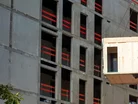Global modular construction market to reach US$191bn by 2027

The global modular construction market is forecast to reach USD$191.62 billion by 2027, according to a new report by Reports and Data, the market research and consulting company.
The report highlighted that rising demand for affordable housing and increasing investments in the development of commercial and healthcare infrastructure is expected to have a positive impact on market growth.
Furthermore, the market is likely to see a renewed interest from the construction and building industry in modular construction, owing to a growing emphasis on workplace safety, efficiency, and productivity, along with reducing the cost and time associated with construction activities. According to industry surveys, modular construction provides a 30%-to-50%-time reduction as compared to conventional construction.
The UK is a market leader due to its high rate of adoption of modular construction, the report said. It added that with the massive ongoing investment into residential housing development, a renewed focus on upgrading healthcare infrastructure, and the chronic shortage of skilled labour, the country’s modular construction market is expected is expected to grow even larger over the next few years.
Meanwhile, in countries like Finland, Sweden and Canada, shorter daytime hours and extremely cold climatic conditions inhibit the growth of traditional construction methods. Therefore, modular construction has emerged as a rational alternative to conventional methods, the report added. It pointed out that by 2018, approximately 85% of all new houses in Sweden were built using modular construction methods.
However, it said that the difficulty of availing finances, the lack of consumer perception, and awareness related to quality were some of the factors inhibiting further market growth around the world. Moreover, the threat of economic slowdown in key markets like the US, UK and China, is expected to be a major barrier for future growth moving forward.
It added that the global construction industry, which was driven by the commercial and residential construction in the US and China, has been affected by the ongoing COVID-19 pandemic, with construction activities halted across the economies.
“The construction industry in the U.S. is estimated to take a major hit because of the lockdown imposed by the government during COVID-19, which is expected to be worsened by the resulting financing pressures due to the non-adherence to the completion times and supply chain issues,” the report said.
Key findings from the report:
- Irrespective of the type of material used, the modular option makes it possible to take advantage of improved quality control, economies of scale, and faster speed, therefore, making it an increasingly attractive option. Moreover, modular construction provides a substantial decrease in waste generation, which its traditional counterparts fail to provide.
- Among the Type segment of the modular construction market, presently, the permanent building is leading the market, and it will continue to dominate the market with an estimated CAGR of 6.5% over the forecasted period. The factors like high-quality control in comparison to on-site construction and the rising need for time-saving and affordable housing solutions will drive the market in this region.
- Rising adoption of modular construction methods to deliver increasing demand for housing is cost-effective and eco-friendly due to reduced waste and efficient in-factory processes. However, a preconceived notion of the residential consumers that modular buildings cannot sustain natural calamities and they comparatively have a shorter life is likely to act as a hurdle in the market growth.
- Among the regional segment of this market, Asia Pacific is estimated to register the highest CAGR of 6.7% during the forecasted period owing to the considerable investments in the infrastructural sector, and an increasing number of new housing units drive the demand for modular construction in this region.
Emerging economies like Saudi Arabia and the UAE are experiencing high demand for non-residential and residential constructions. The rapid urbanisation in these countries demands affordable and faster construction of buildings and facilities with no trade-off on quality grounds. Additionally, rising government investment in infrastructural development offers the potential for market growth in these regions.
- How Industrial Power Connectors Boost Site SafetyConstruction Projects
- IFS and Anthropic: An AI Alliance For Heavy IndustryTechnology & AI
- Currie & Brown: How Global Volatility Hits ConstructionConstruction Projects
- Gensler Leveraging Climate Tech for Built EnvironmentSustainability & Green Building



